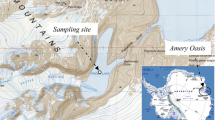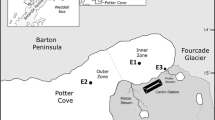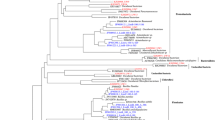Abstract
Araruama Lagoon is an environment characterized by high salt concentrations. The low raining and high evaporation rates in this region favored the development of many salty ponds around the lagoon. In order to reveal the microbial composition of this system, we performed a 16S rRNA gene survey. Among archaea, most clones were related to uncultured environmental Euryarchaeota. In lagoon water, we found some clones related to Methanomicrobia and Methanothermococcus groups, while in the saline pond water members related to the genus Haloarcula were detected. Bacterial community was dominated by clones related to Gamma-proteobacteria, Actinobacteria, and Synechococcus in lagoon water, while Salinibacter ruber relatives dominated in saline pond. We also detected the presence of Alpha-proteobacteria, Pseudomonas-like bacteria and Verrucomicrobia. Only representatives of the genus Ralstonia were cosmopolitan, being observed in both systems. The detection of a substantial number of clones related to uncultured archaea and bacteria suggest that the hypersaline waters of Araruama harbor a pool of novel prokaryotic phylotypes, distinct from those observed in other similar systems. We also observed clones related to halophilic genera of cyanobacteria that are specific for each habitat studied. Additionally, two bacterioplankton molecular markers with ecological relevance were analyzed, one is linked to nitrogen fixation (nifH) and the other is linked to carbon fixation by bacterial photosynthesis, the protochlorophyllide genes, revealing a specific genetic distribution in this ecosystem. This is the first study of the biogeography and community structure of microbial assemblages in Brazilian tropical hypersaline environments. This work is directed towards a better understanding of the free-living prokaryotic diversity adapted to life in hypersaline waters.





Similar content being viewed by others
References
Abed RM, Kohls K, de Beer D (2007) Effect of salinity changes on the bacterial diversity, photosynthesis and oxygen, consumption of cyanobacterial mats from an intertidal flat of the Arabian Gulf. Environ Microbiol 9(6):1384–1392
Andrade L, Gonzalez AM, Araújo FV, Paranhos R (2003) Flow cytometry assessment of bacterioplankton in tropical marine environments. J Microbiol Methods 55:841–850
Antón J, Rosselló-Mora R, Rodríguez-Valera F, Amann RI (2000) Extremely halophilic bacteria in crystallizer pondsfrom solar salterns. Appl Environ Microbiol 66: 3052–3057
Antón J, Oren A, Benlloch S, Rodríguez-Valera F, Amann R, Rosselló-Mora R (2002) Salinibacter ruber gen. nov., sp. nov., a novel, extremely halophilic member of the bacteria from saltern crystallizer ponds. Int J Syst Evol Microbiol 52:485–491
Benlloch S, Acinas SG, Anton J, Lopez-Lopez A, Luz SP, Rodriguez-Valera F (2001) Archaeal biodiversity in crystallizer ponds from a solar saltern: culture versus PCR. Microb Ecol 41(1):12–19
Benlloch S, Lopez-Lopez A, Casamayor EO, Ovreas L, Goddard V, Daae FL, Smerdon G, Massana R, Joint I, Thingstad F, Pedros-Alio C, Rodriguez-Valera F (2002) Prokaryotic genetic diversity throughout the salinity gradient of a coastal solar saltern. Environ Microbiol 4:349–360
Braga CZF, Vianna ML, Kjerfve B (2003) Environmental characterization of a hypersaline coastal lagoon from Landsat-5 Thematic Mapper data. Int J Remote Sens 24:3219–3234
Burns BP, Goh F, Allen M, Neilan BA (2004) Microbial diversity of extant stromatolites in the hypersaline marine environment of Shark Bay, Australia. Environ Microbiol 6(10):1096–1101
Chen F, Wang K, Kan J, Suzuki MT, Wommack KE (2006) Diverse and unique picocyanobacteria in Chesapeake Bay, revealed by 16S-23S rRNA internal transcribed spacer sequences. Appl Environ Microbiol 72:2239–2243
Clementino MM, Fernandes CC, Vieira RP, Cardoso AM, Polycarpo CR, Martins OB (2007) Archaeal diversity in naturally occurring and impacted environments from a tropical region. J Appl Microbiol 103:141–151
Cole JR, Chai B, Marsh TL, Farris RJ, Wang Q, Kulam SA et al (2003) The Ribosomal Database Project (RDP-II): previewing a new autoaligner that allows regular updates and the new prokaryotic taxonomy. Nucleic Acids Res 31: 442–443
DeLong EF (1992) Archaea in coastal marine environments. Proc Natl Acad Sci USA 89(12):5685–5689
DuRand MD, Olson RJ, Chisholm SW (2001) Phytoplankton population dynamics at the Bermuda Atlantic Time-series station in the Sargasso Sea. Deep Sea Res Part II 48:1983–2003
Dyble J, Paerl HW, Neilan BA (2002) Genetic characterization of Cylindrospermopsis raciborskii (cyanobacteria) isolates from diverse geographic origins based on nifH and cpcBA-IGS nucleotide sequence analysis. Appl Environ Microbiol 68:2567–2571
Ewing B, Hillier L, Wendl MC, Green P (1998) Base-calling of automated sequencer traces using phred I accuracy assessment. Genome Res 8:175–185
Fay P (1992) Oxygen relations of nitrogen fixation in cyanobacteria. Microbiol Rev 56:340–373
Gasol JM, del Giorgio PA (2000) Using flow cytometry for counting natural planktonic bacteria and understanding the structure of planktonic bacterial communities. Scientia Marina 64:197–224
Grant WD (2004) Life at low water activity, review. Philos Trans R Soc Lond B Biol Sci 29:359(1448):1249–1267
Grasshoff K, Kremling K, Erhardt M (1999) Methods of seawater analysis. 3rd edn. Wiley-VCH, Germany, p 600
Hess WR (2004) Genome analysis of marine photosynthetic microbes and their global role. Curr Opin Biotechnol 15(3):191–198
Hurlbert SH (1971) The nonconcept of species diversity: a critique and alternative parameters. Ecology 52:577–586
Jungblut AD, Hawes I, Mountfort D, Hitzfeld B, Dietrich DR, Burns BP, Neilan BA (2005) Diversity within cyanobacterial mat communities in variable salinity meltwater ponds of McMurdo Ice Shelf. Antarctica Environ Microbiol 7(4):519–529
Kimura M (1980) A simple method for estimating evolutionary rates of base substitutions through comparative studies of nucleotide sequences. J Mol Evol 16:111–120
Kirchman DL, K’nees E, Hodson R (1985) Leucine incorporation and its potential as a measure of protein synthesis by bacteria in natural aquatic systems. Appl Environ Microbiol 49: 599–607
Kirkwood AE, Buchheim JA, Buchheim MA, Henley WJ (2007) Cyanobacterial diversity and halotolerance in a variable hypersaline environment. Microb Ecol [Epub ahead of print]
Kjerfve B, Schettini CA F, Knoppers B, Lessa AG, Ferreira HO (1996) Hydrology and salt balance in a large, hypersaline coastal lagoon: Lagoa de Araruama, Brazil. Estuar Coast Shelf Sci 42:701–725
Kumar S, Tamura K, Jakobsen IB, Nei M (2001) MEGA2: molecular evolutionary genetics analysis software. Bioinformatics 17:1244–1245
Lane DJ, Pace B, Olsen GJ, Stahl D, Sogin M, Pace NR (1985) Rapid determination of 16S ribosomal RNA sequences for phylogenetic analyses. Proc Natl Acad Sci USA 82:6955–6959
Lane DJ (1991) 16S/23S rRNA sequencing. In: Stackebrandt E, Goodfellow M (eds) Nucleic acid techniques in bacterial systematics. Wiley, New York, pp 115–175
Ley RE, Harris JK, Wilcox J, Spear JR, Miller SR, Bebout BM, Maresca JA, Bryant DA, Sogin ML, Pace NR (2006) Unexpected diversity and complexity of the Guerrero Negro hypersaline microbial mat. Appl Environ Microbiol 72:3685–3695
Maturrano L, Santos F, Rossello-Mora R, Anton J (2006) Microbial diversity in Maras salterns, a hypersaline environment in the peruvian andes. Appl Environ Microbiol 72:3887–3895
Mehta MP, Butterfield DA, Baross JA (2003) Phylogenetic diversity of nitrogenase (nifH) genes in deep-sea and hydrothermal vent environments of the Juan de Fuca Ridge. Appl Environ Microbiol 69(2):960–970
Moreira-Turcq PF (2000) Impact of a low salinity year on the metabolism of a hypersaline coastal lagoon (Brazil). Hydrobiologia 429:133–140
Nomata J, Mizoguchi T, Tamiaki H, Fujita Y (2006) A second nitrogenase-like enzyme for bacteriochlorophyll biosynthesis: reconstitution of chlorophyllide a reductase with purified X-protein (BchX) and YZ-protein (BchY-BchZ) from Rhodobacter capsulatus. J Biol Chem 281:15021–15028
Nubel U, Garcia-Pichel F, Clavero E, Muyzer G (2000) Matching molecular diversity and ecophysiology of benthic cyanobacteria and diatoms in communities along a salinity gradient. Environ Microbiol 2:217–226
Oren A (2002) Molecular ecology of extremely halophilic archaea and bacteria. FEMS Microbiol Ecol 39:1–7
Ovreas L, Daae FL, Torsvik V, Rodriguez-Valera F (2003) Characterization of microbial diversity in hypersaline environments by melting profiles and reassociation kinetics in combination with terminal restriction fragment length polymorphism (T-RFLP). Microb Ecol 46:291–301
Oz A, Sabehi G, Koblízek M, Massana R, Béjà O (2005) Roseobacter-like bacteria in Red and Mediterranean Sea aerobic anoxygenic photosynthetic populations. Appl Environ Microbiol 71:344–353
Saitou N, Nei M (1987) The neighbour-joining method: a new method for reconstructing phylogenetic trees. Mol Biol Evol 4: 406–425
Simberloff D (1978) Use of rarefaction and related methods in ecology. In: Dickson KL, Cairns J, Livingston RJ (eds) Biological data in water pollution assessment: quantitative and statistical analyses, ASTM STP 652. American Society for Testing and Materials, Philadelphia, pp 150–165
Smith DC, Azam F (1992) A simple, economical method for measuring bacterial protein synthesis rates in seawater using super(3)H-leucine. Mar Microb Food Webs 6:2107–2114
Singleton DR, Furlong MA, Ratbhun SL, Whitman WB (2001) Quantitative comparisons of 16S rRNA gene sequence libraries from environmental samples. Appl Environ Microbiol 67:4374–4376
Souza MFL, Kjerfve B, Knoppers B, Landim de Souza WF, Damasceno RN (2003) Nutrient budgets and trophic state in a hypersaline coastal lagoon: Lagoa de Araruama, Brazil. Estuar Coast Shelf Sci 57:843–858
Somerville CC, Knight IT, Straube WL, Colwell RR (1989) Simple rapid method for direct isolation of nucleic acids from aquatic environments. Appl Environ Microbiol 55:548–554
Thompson JD, Gibson TJ, Plewniak F, Jeanmougin F, Higgins DG (1997) The ClustalX windows interface: flexible strategies for multiple sequence alignment aided by quality analysis tools. Nucleic Acids Res 24:4876–4882
Urbach E, Kevin LV, Young L, Morse A, Larson GL, Giovannoni SJ (2001) Unusual bacterioplankton community structure in ultra-oligotrophic Crater Lake. Limnol Oceanogr 46:557–572
Ventosa A, Nieto JJ, Oren A (1998) Biology of moderately halophilic aerobic bacteria. Microbiol Mol Biol Rev 62(2):504–544
Vieira RP, Clementino MM, Cardoso AM, Oliveira DN, Albano RM, Gonzalez AM, Paranhos R, Martins OB (2007) Archaeal communities in a tropical estuarine ecosystem: Guanabara Bay, Brazil. Microb Ecol 54(3):460–468
Vieira RP, Gonzalvez ASM, Cardoso AM, Oliveira DM, Albano RM, Clementino MM, Martins OB, Paranhos R (2008) Relationships between bacterial diversity and environmental variables in a tropical marine environment, Rio de Janeiro. Environ Microbiol 10(1):189–199
Acknowledgments
We gratefully acknowledge the Genome Sequencing Core-PDTIS/FIOCRUZ. We thank the Limnology Laboratory of UFRJ for the access to a liquid scintilator. We also would like to thank Dr. Ivano de Filippis for his critical reading of the manuscript. This work was supported by Coordenação de Aperfeiçoamento de Pessoal de Ensino Superior (CAPES), Conselho Nacional de Desenvolvimento Científico e Tecnológico (CNPq), Fundação Carlos Chagas Filho de Amparo a Pesquisa do Estado do Rio de Janeiro (FAPERJ) and INCQS/FIOCRUZ.
Author information
Authors and Affiliations
Corresponding author
Additional information
Communicated by K. Horikoshi.
Rights and permissions
About this article
Cite this article
Clementino, M.M., Vieira, R.P., Cardoso, A.M. et al. Prokaryotic diversity in one of the largest hypersaline coastal lagoons in the world. Extremophiles 12, 595–604 (2008). https://doi.org/10.1007/s00792-008-0162-x
Received:
Accepted:
Published:
Issue Date:
DOI: https://doi.org/10.1007/s00792-008-0162-x




